Military
When the South African government, despite opposition from many Afrikaners, decided to send troops to England in August 1914, a group of prominent South Africans living in London formed a Committee to start a fund for the establishment of a hospital and to provide general comforts for the troops. Lord Gladstone (1854-1930), until recently the Governor-General of the Union of South Africa, became its Chairman.
The initial proposal, to build a South African wing to the Royal Victoria Hospital at Netley, met with disfavour when it was decided that, while ideal in summer, the site would not be suitable for South Africans troops in the winter months. Further sites were investigated and eventually a site in Richmond Park, graciously provided by the King, was chosen for the hutted hospital.
It had been intended that the Hospital would have 500 beds but, because of financial restrictions, only 300 could at first be provided (the plans allowed for more to be added later). Building work began early in March 1916 and the South African Hospital was officially opened four months later on 16th June by Princess Christian. The Hospital, fully equipped, was then taken over by the Deputy Director of Medical Services, London District, on behalf of the Army Council as a gift from the South Africans.
The Hospital site comprised about 12 acres, although the buildings covered less than three acres. The ward huts and principal rooms were made of timber with an external lining of felt and weather-board. The inside walls and ceilings were lined with asbestos boards. One special feature of the Hospital was a bath ward, equipped with six fire-clay continuous baths, for the treatment of patients with severe wounds.
The medical staff consisted of 13 officers of the South African Medical Corps (SAMC) and 11 civilian practitioners who, for various reasons, were not eligible for commissions in the SAMC. The nursing staff belonged mostly to the QAIMNS Reserve or to the South African Military Nursing Service, and consisted of a Matron, 2 Assistant Matrons, 23 Sisters, 55 Staff Nurses and 88 probationers (most of whom were South African). The ward orderlies were mainly NCOs and other ranks who had been invalided from the Front and were working at the Hospital while recovering their health and strength.
The Hospital also served as a depot for subordinate personnel of the SAMC. Eighteen drafts, comprising 423 men, were sent as reinforcement for the No. 1 South African General Hospital and the No. 1 South African Field Ambulance in France.
From the first, the Committee made funds available to provide comforts and entertainments for the patients, initially under the organisation of Lady Phillips until it was taken over by the Red Cross subcommittee of the Fund. Every possible amusement was provided. Some form of entertainment was staged on four or five evenings a week in the Hospital's concert hall. Every week a visit to the theatre or a place of interest was arranged. The 'African World' War Comforts Service arranged river trips, and also provided gifts of fruit and other comforts. Lady Phillips founded a Riverside Club near to the Hospital, for convalescent patients to relax in and enjoy the garden and riverside views.
Arrangements for occupational work for those too weak yet to get out of bed were provided, in the early days, by lady visitors. Materials for needlework were given to the patients, who were encouraged to embroider regimental crests and other items of a similar nature.
In September 1916 the Army Council decided to extend the Hospital and the Committee felt that, as the original plan had been for 500 beds, it would undertake the building work. Funds needed to be raised for this, but to avoid delay, a substantial sum of money was donated by the German-born financier, Otto Beit. At the end of December, as part of the fund-raising scheme, the Committee offered the privilege of naming a bed to any institution or member of the public making a gift of £25. A ward could be named for a donation of £600.
The Appeal was successful and resulted in 99 beds and eight wards being named (about 265 of the beds were the gifts of South African schools). The principal corridors and rooms in the Hospital were named after well-known towns and streets in South Africa. Name plates were placed over the beds, so that familiar names greeted South African patients and visitors.
The extension opened in February 1917, but it was hardly in use before there was a demand for further beds. The Committee solved this by converting the staff quarters originally built for orderlies into wards. A neighbouring house was rented for use as an annexe.
The problem of how to deal with the permanently disabled men at the Hospital had to be faced early in the war. The Commandant of the Hospital, Lt. Col. Edward Thornton, inaugurated a vocational training scheme. After negotiations with the War Office, construction of workshops had begun in November 1916. The cost of the buildings - £2,235 - was borne by the South African Hospital and Comforts Fund and the Governor-General's Fund.The South African Vocational Training School opened in February 1917. Although much of the equipment was donated or borrowed, some £1,200 had to be spent on the purchase of tools and appliances; this sum was defrayed by the Governor-General's Fund. Four houses in the vicinity were rented to house the students who had been discharged from the Hospital. The cost of these - £1,400 - was met by the two Funds. Patients had been encouraged to think about their future while still undergoing treatment, so that when they were well enough, they would be keen to go to the classrooms and undertake extensive courses of training.
In May 1917, when Queen Alexandra visited, the Hospital had 620 beds.
At the beginning of 1918 the War Office, having noticed that the adjacent Richmond Military Hospital was almost entirely full of South African wounded, proposed to the Committee that the Hospitals should amalgamate. The Committee readily agreed and, on 1st July 1918, the combined Hospitals became the South African Military Hospital, with 1,098 beds.
The need for more beds remained, however, and 250 emergency beds were added by billeting patients in houses within the neighbourhood. Four auxiliary hospitals were also attached to the main Hospital, giving a total number of 1,321 beds (1,571 including billets).
The Richmond Park section was equipped by the Committee, and the Grove Road section by the Board of Guardians and the War Office (and sometimes, where necessary, by the Committee). During the war the Committee had spent some £45,000 on building and extending the Hospital, including a concert hall and the workshops, and £19,000 on equipment, including replacements.
By the end of October 1918 the number of patients admitted to the Hospital during the war was 274 officers and 9,142 other ranks (these figures do not include those admitted to the Richmond Military Hospital prior to amalgamation). Of these 9,686 patients, 2,628 belonged to Imperial units, but included many South Africans; 7,058 were members of the South African Contingent. The number of operations performed under general anaesthetic totalled 2,125. Some 8,260 patients were discharged, of whom 6,230 were members of the Contingent.
Most of the swabs and bandages used in the Hospital had been manufactured in workrooms organised by a group of ladies attached to the South African Comforts Committee. The workrooms had also produced most of the curtains and similar articles for the wards, and had undertaken most of the mending.
The number of disabled men attending the South African Vocational Training School since its commencement was 393. By 31st October 1918, 226 had left and only 167 remained - 112 of whom had been discharged from the Hospital; 55 were still receiving treatment. The Scheme had been successful, both in improving the morale of the limbless men and in retraining them, with due regard to their disabilities, to be able to earn a living in civilian life, and thus be self-sufficient in the community. Somewhat belatedly, the necessity of providing training for permanently disabled servicemen while undergoing hospital treatment was finally endorsed at the Inter-Allied Conference on Disablement Problems in May 1918.
The Hospital closed in 1921.
Present status (September 2010)
The Hospital was demolished in 1925. The site reverted to being part of Richmond Park.
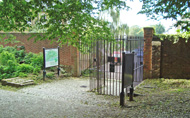
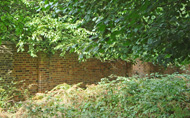
The Cambrian Gate, pedestrian entrance into the northwest corner of Richmond Park (left). A new perimeter wall dividing the site of the two hospitals (right).
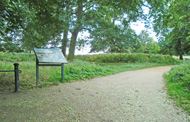
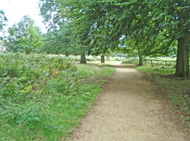
The approach from the Cambrian Gate to the Bishop's Pond.
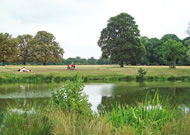
Looking across Bishop's Pond towards Conduit Wood. The South African Hospital occupied 12 acres of this area.
More than 146,000 South Africans served during WW1, fighting in Africa and France. By the end of the war, about 10,000 troops had been wounded on the French front, and 5,000 killed.
Some 39 South African troops were buried in Richmond Cemetery in what was known during the war as the 'soldiers' corner'.
After the war the Committees for the South African Military Hospital and the Comforts Fund decided to erect a memorial to their fellow countrymen who died in battle. Sir Edwin Lutyens (1869-1944) was invited to design the memorial.
The memorial was unveiled by General Jan Smuts (1870-1950) in June 1921 and was much visited by South Africans during the 1920s and 1930s, but gradually became forgotten.
In 1981 the Commonwealth War Graves Commission agreed to maintain the memorial on behalf of the South African government.
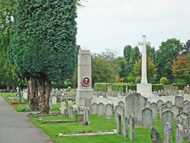
The Memorial in Richmond Cemetery is adjacent to the Cross of Sacrifice.
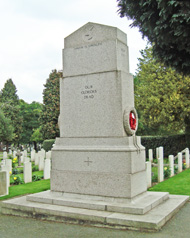
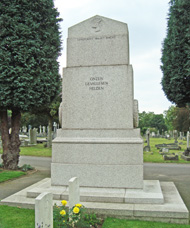
The memorial obelisk, dated 1919, is 15 feet high and made of granite. It beats a strong resemblance to the Cenotaph in Whitehall, which Lutyens also designed. The northwest side of the memorial bears the inscriptions "Union is Strength" and "Our Glorious Dead" in English (left) and, on the southeast side "Eendraght maakt Macht" and "Onzen Gevallenen Helden" in Afrikaans (right).
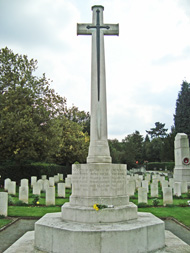
The inscriptions on the Cross of Sacrifice read "This Cross of Sacrifice is one in design and intention with those which have been set up in France and Belgium and other places throughout the world where our dead of the Great War are laid to rest" and "Their name liveth forever".
(Author unstated) 1917 Care of the wounded. British Journal of Nursing, 12th May, 324.
Buchan J 1920 The History of the South African Forces in France. London, Thomas Nelson & Sons.
http://1914-1918.invisionzone.com (1)
http://1914-1918.invisionzone.com (2)
http://paperspast.natlib.govt.nz
http://rapidttp.co.za
www.1914-1918.net
Return to home page